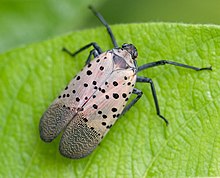| Spotted lanternfly | |
|---|---|

| |
| At Brooklyn Botanic Garden, New York | |
| Scientific classification | |
| Domain: | Eukaryota |
| Kingdom: | Animalia |
| Phylum: | Arthropoda |
| Class: | Insecta |
| Order: | Hemiptera |
| Suborder: | Auchenorrhyncha |
| Infraorder: | Fulgoromorpha |
| Family: | Fulgoridae |
| Genus: | Lycorma |
| Species: | L. delicatula
|
| Binomial name | |
| Lycorma delicatula (White, 1845)
| |
| Subspecies[1] | |
| Synonyms | |
| |
The spotted lanternfly (Lycorma delicatula) is a planthopper indigenous to parts of China and Vietnam. It has spread invasively to Japan, South Korea, and the United States, where it is often referred to by the acronym "SLF".[2] Its preferred host is tree of heaven (Ailanthus altissima), but it feeds on crops including soybean, grapes, stone fruits, and Malus spp.[3] In its native habitat, L. delicatula populations are regulated by parasitic wasps.
The spotted lanternfly's life cycle is often centered on its preferred host, Ailanthus altissima, but L. delicatula can associate with more than 173 plants. Early life stages (instars) of the spotted lanternfly are characterized by spotted black and white nymphs that develop a red pigmentation and wings as they mature. Early life instars have a large host range that narrows with maturation. Adult spotted lanternflies have a black head, grey wings, and red hind wings. Adults do not have any specialized feeding associations with herbaceous plants but cause extensive damage to crops and ornamental plants. The piercing wounds caused by their mouthparts and the honeydew waste they excrete are harmful to the health of host plants. They feed on the sap of host plants, including the tree of heaven, an invasive tree.[4] The damage to native hardwood forests which was feared at the outset did not come to pass.[5] Unlike some insects, the spotted lanternfly does not pose direct danger to humans through biting or stinging.[6] Spotted lanternflies lay egg masses containing 30–50 eggs, often covered with a grayish mud-like coating.[7]
The species was introduced into South Korea in 2006 and Japan in 2009, and has since been considered a pest. In September 2014, L. delicatula was first recorded in the United States, and as of 2022,[update] it is considered an invasive species in much of the Northeastern United States and is rapidly spreading south and west.[8] L. delicatula's egg masses are the primary vector of spread, with Ailanthus altissima populations seen as a risk factor for further infestation globally. Ongoing pest control efforts have sought to limit population growth, due to the threat L. delicatula poses to global agricultural industries. Parts of the United States are undergoing massive pest control efforts to cull the spotted lanternfly's population. However, this process indirectly harms other species.[9]
- ^ "Bourgoin T: Fulgoromorpha Lists On the Web (FLOW): Lycorma delicatula (White, 1845) (retrieved 26 April 2020)". Archived from the original on 1 August 2020. Retrieved 26 April 2020.
- ^ CDFA: Spotted Lanternfly
- ^ Cite error: The named reference
Worldwide-Hostswas invoked but never defined (see the help page). - ^ "Spotted lanternfly lore: Penn State experts clear up falsehoods about pest | Penn State University". www.psu.edu. Retrieved 22 September 2024.
- ^ "Invasive spotted lanternfly may not damage hardwood trees as previously thought | Penn State University". www.psu.edu. Retrieved 22 September 2024.
- ^ "Spotted lanternfly lore: Penn State experts clear up falsehoods about pest | Penn State University". www.psu.edu. Retrieved 22 September 2024.
- ^ "Spotted Lanternfly Pest Alert" (PDF). USDA-APHIS. USDA. Archived (PDF) from the original on 23 January 2023. Retrieved 23 January 2023.
- ^ "Spotted Lanternfly Map". Stop SLF. USDA. Archived from the original on 23 January 2023. Retrieved 23 January 2023.
- ^ Djajapranata, Cliff (20 November 2023). "Unearthing a Better Way to Use Pesticides". Georgetown University. Retrieved 22 September 2024.